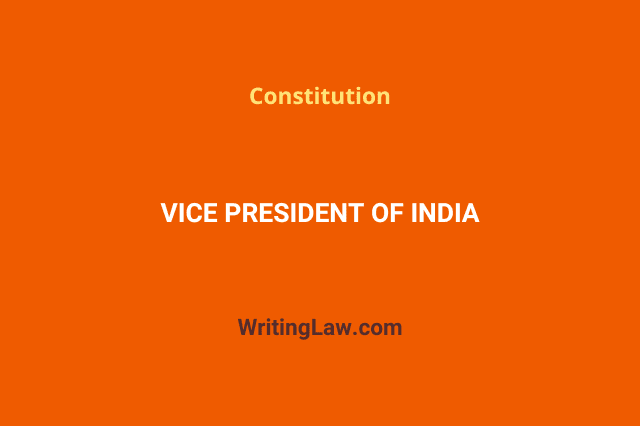
The Vice President is the second-highest constitutional post in India. The Vice President serves as the ex-officio Chairman of the Rajya Sabha and is a member of the Indian Parliament. As per Article 63 of the Indian Constitution, India must have a Vice President.
In this article, you will primarily read about the qualifications, appointment, functions, office term, and removal of the Vice President of India.
The Qualifications Needed for Becoming the Vice President of India
Article 66(3) of the Constitution talks about the qualifications for election as Vice President in India. The qualifications of the Vice President are the same as those of the President of India.
Accordingly, an Indian citizen of not less than 35 years of age is qualified for the appointment as Vice President. The Vice President must also be qualified to be elected as a Rajya Sabha (Council of State) member.
Further, the Vice President of India cannot hold an office of profit under the central government, the state government, or any local or other authority controlled by any of the aforementioned governments.
Must Read: How the President of India Is Elected
Election of the Vice President of India
According to Article 66(1) of the Indian Constitution, the Vice President of India is elected indirectly by the electoral college by secret ballot in a joint session using the proportional representation system by means of a single transferable vote. The electoral college comprises members of both Houses of Parliament (elected and nominated).
Note: Any dispute related to the election of the Indian Vice President is inquired about and decided by the Supreme Court.
Jagdeep Dhankar is the present Vice President, and he took office as the 14th Vice President of India on August 11, 2022. Before him, M Venkaiah Naidu had served as India’s vice president since August 11, 2017.
Term and Removal of the Vice President of India
The term and removal of the Vice President are provided under Article 67 of the Indian Constitution. The term of office of the Vice President in India is five years. However, he/she may resign from his/her office before the expiry of the normal term by writing to the President of India.
The Vice President can be removed from his office by passing a resolution by the majority of all the then members (effective majority) of the Rajya Sabha and agreed by the Lok Sabha. However, a prior notice of 14 days must be given to the Vice President before moving such a resolution.
Further, the Vice President continues to serve his office until his successor enters the office.
Note: Unlike the President of India, the Vice President has no impeachment process. Impeachment and removal are two different concepts. The impeachment procedure is only exercised for the President and no other official in India.
Functions of the Indian Vice President
These are the functions of the Vice President of India:
- The Vice President acts as the ex officio Chairman of the Rajya Sabha.
- He presides over the meetings of the Rajya Sabha. However, he does not have the right to vote as he is not a member of the Rajya Sabha.
- As per Article 65 of the Indian Constitution, when the office of the President becomes vacant due to resignation, death, removal, or other reasons, the Vice President accepts the presidency and acts as the President of India.
- The Vice President does not perform the duties of the Chairman of the Rajya Sabha while discharging the functions of the President. The Deputy Chairman of Rajya Sabha performs such duties of the Chairman during the period the Vice President does not perform them.
- The Vice President also performs the functions of the President when he himself is unable to do so due to absence, illness or other causes until the President resumes his duties.
- The Vice President is entitled to all the powers and immunities along with the emoluments, allowances and privileges that are bestowed upon the President during the period he is serving as President of India.
Read Next: 9 Powers of the President of India
- Understanding the Legislative Branch of the Indian Government - 6th May 2024
- Appointment, Oath, and Removal of Constitutional Posts in India - 28th April 2024
- Powers of Income Tax Authorities in India - 26th April 2024







